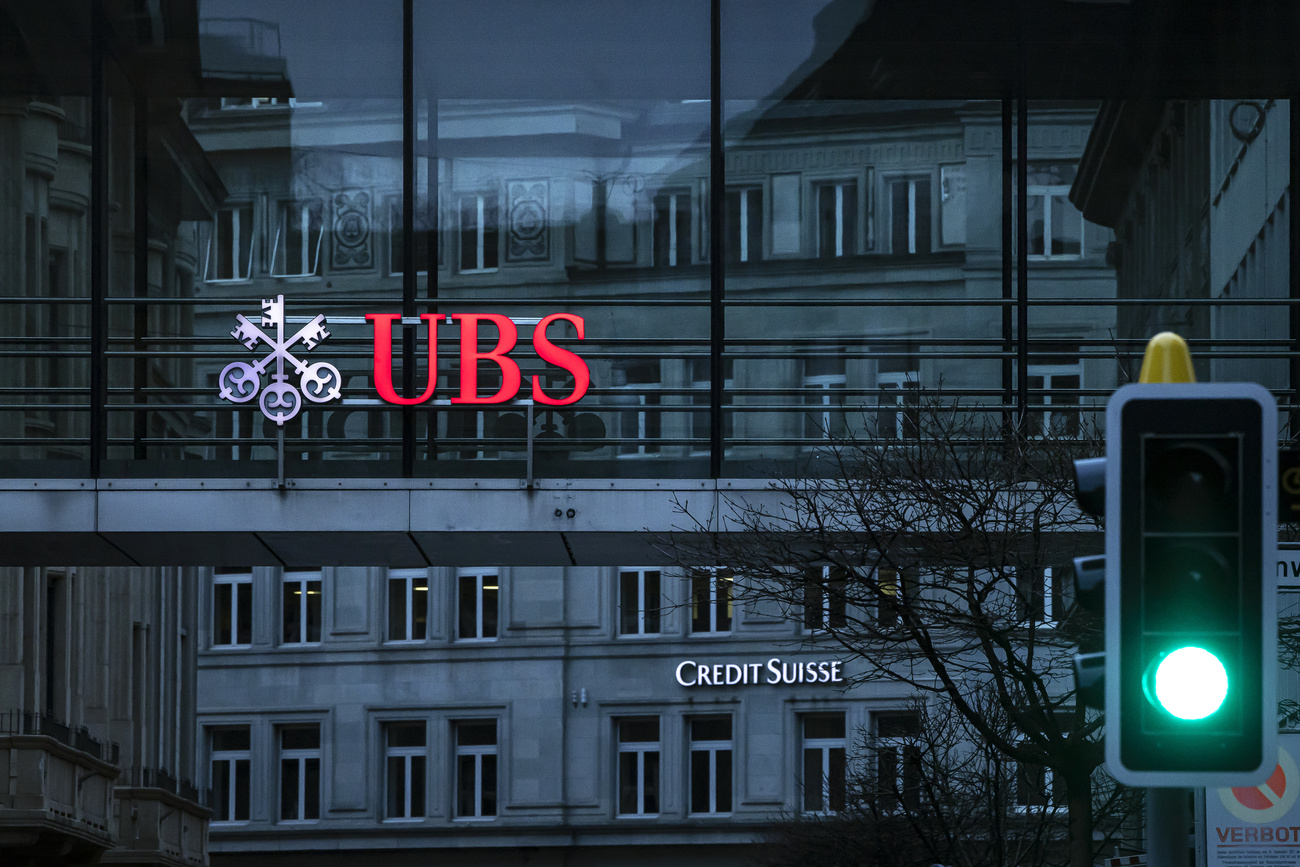Credit Suisse: the ‘credit locomotive’ has run out of steam

The history of Credit Suisse epitomises the transformation of the Swiss financial industry from discreet bankers who profited from capital flight and banking secrecy to risk-taking investment bankers.
Back in the 1980s, people might have been forgiven for believing that Switzerland belonged to Schweizerische Kreditanstalt (SKA), as Credit Suisse was then called. Thousands of Swiss children used to wear cherry-red and sky-blue Schweizerische Kreditanstalt hats with a stylised cross on it. Malicious voices even blamed the bank for a nationwide plague of lice in schools because the children were forever getting their hats mixed up. By 1977, 800,000 hats had been distributed; this popular freebie remained in production until 1993. The Swiss equivalent of the Volkswagen Golf car generation in Germany was the Schweizerische Kreditanstalt generation.
More
In the autumn of 2022, people jokedExternal link that these cult hats, which can still be found online today, were a far better investment than a share in Credit Suisse. The jokes proved right: UBS has incorporated the remnants of Credit Suisse, which collapsed over the weekend.
Myths and nostalgia
Nostalgia will probably drive the price of the hats even higher. The origins of Credit Suisse go back to the mythically exaggerated beginnings of Switzerland Inc., or as Friedrich Dürrenmatt called it “Unternehmen ‘Schweiz’” – the boom years of the 19th century, when Switzerland emerged from abject poverty to become an industrial power. Schweizerische Kreditanstalt was founded by a towering figure, a man of action still admired by many: Alfred Escher.
Beneath his statue in front of Zurich’s main railway station, water-spouting dragons still remind us that he had rivers straightened. He is also credited with the drilling of the Gotthard massif. Escher’s Northeast Railway (Nordostbahn), with hundreds of kilometres of track, provided the foundation for the Swiss railways.

More
How the Swiss ‘trinity’ forced UBS to save Credit Suisse
The financial heavyweight behind all this was Schweizerische Kreditanstalt, which Escher had founded with other industrialists in 1856. His “credit locomotive” supplied Escher with the capital he needed to expand his railway network. As one of the first major Swiss banks, it was able to grant the big loans needed to fund the country’s industrialisation.
In 1870, Schweizerische Kreditanstalt expanded and opened branches in New York and Vienna. In Switzerland, the focus was on Zurich. From 1876, the main branch was located on Zurich’s Paradeplatz, which today epitomises the power of the Swiss banks. In 1897, Schweizerischer Bankverein, which was later absorbed by UBS, also settled there. This is where a battle for supremacy finally came to an end when the UBS takeover began.

After the First World War, capital flight caused a meteoric rise in the Swiss banking sector. Schweizerische Kreditanstalt attributed the growth of its foreign business before 1928 to “specially trained personnel”. During the Second World War, Schweizerische Kreditanstalt like other Swiss banks, conducted business with the Nazis and knowingly accepted looted gold. (Later, in the 1960s, the Credit Suisse business bulletin was the first to spread the bizarre idea that banking secrecy had been established in 1934 to protectExternal link Jewish accounts from the Nazis).
Bouncing back from scandal
After the Second World War, the bank’s ascent continued unabated: in 1945, the Schweizerische Kreditanstalt managed CHF3.9 billion in securities, but by 1970 it had CHF47 billion under management. It traded in foreign exchange and even had its own gold refinery in canton Ticino. And while banking secrecy meant it accepted money from every country in the world, Credit Suisse tended to avoid expansionist adventures abroad.
For a long time, Credit Suisse attracted less attention than Bankverein and Schweizerische Bankgesellschaft, which would also be absorbed by UBS in 1998. This was in part down to its reputation as a serious, conservative bank.
The famous hats that begin every text about Credit Suisse were part of an image campaign to win over small savers and the hearts of the Swiss population. The bank communicated more openly and courted small savers; from 1970 onwards, it also offered a savings account for young people.

But in 1977 the “Chiasso scandal” shook the bank. For years, Schweizerische Kreditanstalt had been accepting undeclared money from wealthy Italians through camouflaged financial vehicles in Liechtenstein – in total more than CHF2 billion – and in addition had invested it badly. Schweizerische Kreditanstalt stood accused not only of money laundering, but also of incompetence.
But Credit Suisse went on the offensive: some management heads rolled. Above all, however, it convinced the public of its trustworthiness in a public relations campaign by flooding the hat market and becoming omnipresent as a sports sponsor. “SKA is there for everyone” became the new slogan.
The ambivalence of this slogan emerged in 2022 with the publication of Suisse Secrets, a massive data leak which revealed how tightly enmeshed the bank still was in the global business of asset concealment. The bank’s clients are said to have included members of the Mafia, secretive criminal gangs of Italian origin.
But the handling of the 1977 crisis was, as the German-language Neue Zürcher Zeitung newspaper wrote at the time, “reinterpreted as a symbol of the institution’s strength”. The reputation for bouncing back from every crisis accompanied Credit Suisse to its end.
Rise of the bankers
The 1977 crisis also led to a painful loss of CHF1.4 billion, which could not be compensated for by handing out free merchandise and attracting small deposit accounts. In 1978, Schweizerische Kreditanstalt entered investment banking and Credit Suisse Holding was founded as a sister company to hold stakes in industrial companies.
In 1988, this holding company took over First Boston, which had made a name for itself as a financial institution through particularly aggressive behaviour in the investment banking boom of the 1980s. The takeover cost more than CHF20 billion: an order of magnitude that had never been reached by a Swiss company.
+ Credit Suisse collapse: consequences and open questions
In 1997, Credit Suisse Holding became Credit Suisse Group. This time it pipped neighbours on Paradeplatz to the post: Schweizer Bankgesellschaft and Bankverein merged to form UBS in 1998. Both big banks aimed to expand.
In the 1990s, the industry began to consolidate. In 1990, there were still 495 banks in Switzerland, but by 2020 there were 243External link. Credit Suisse Holding Group began a shopping spree with the purchase of Bank Leu, a Swiss bank, followed later by Volksbank and Neue Aargauer Bank.
By the end of 2000, Credit Suisse employed about 80,000 people worldwide, 28,000 of them in Switzerland. The share price at the end of the year was about CHF100, and profits were CHF5.7 billion.
Showdown on Paradeplatz
While restructuring in the 1990s, the name Schweizerische Kreditanstalt disappeared. As the bank became increasingly international, cultural change crept in – the traditional banker who discreetly managed all kinds of money from all over the world was replaced by a version more willing to take risks.
This was also reflected in salaries. At the beginning of the 2000s, there was a short but severe recession – 20,000 jobs were lost and the share price fell below CHF20. Nevertheless, bonuses continued to explode. In 2006, the bank paid a dismissed employee in the US no less than $120 million in compensation for his troubles.
In the 2008 crash, the bank was able to stay afloat with the help of investors from Qatar– it refused state aid, whereas UBS had to be rescued by a government decision. It appeared that the battle of Paradeplatz was won, and Credit Suisse had emerged with flying colours. But the dark clouds hovering over the big bank would not disappear in the years to follow.

More
Where did it all go wrong for Credit Suisse?
Credit Suisse took greater risks and lowered its equity ratio. At the same time, it hit the headlines for horrendously high salary and bonus payments. In 2014, Credit Suisse bankers stood trial in the US for tax evasion – the bank paid a hefty fine.
In 2020, Credit Suisse was accused of shadowing a star banker for fear that he would defect to its competitor UBS – the board of directors came under fire. In 2021, the two investment funds Greensill and Archegos collapsed, tearing a gaping hole worth billions in Credit Suisse’s balance sheet.
At the end of last year, Saudi National Bank became a major shareholder in Credit Suisse. But this time, the attempted rescue with money from the Middle East came to nothing. Anyone who looks up at Zurich’s Paradeplatz in the future will notice that there is only one bank’s name: UBS.

More
Bank it

In compliance with the JTI standards
More: SWI swissinfo.ch certified by the Journalism Trust Initiative













You can find an overview of ongoing debates with our journalists here . Please join us!
If you want to start a conversation about a topic raised in this article or want to report factual errors, email us at english@swissinfo.ch.